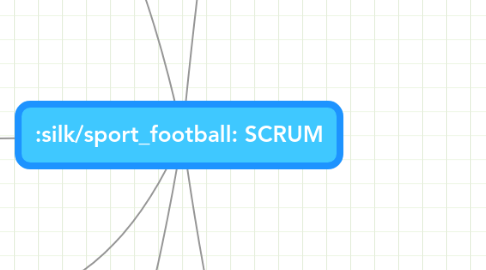
1. Roles
1.1. Product Owner
1.1.1. Maximising ROI
1.1.2. Identify features
1.1.3. Prioritise items on list
1.2. Scrum Master
1.2.1. Facilitator
1.3. The Team
1.3.1. 7±2 members
1.3.2. 100% available for sprint
1.3.3. Includes all expertise
1.3.3.1. No task assignment
1.3.3.2. Members take task
1.3.3.2.1. Support Pairing
1.3.4. Self-organising
1.3.4.1. Autonomy
1.3.4.2. Accountable
1.3.5. Should be stable
1.3.6. Have velocity
2. Arjen Douwes
2.1. Version 1.3
2.2. arjendouwes@gmail.com
3. Scrumboard
3.1. Tasks
3.1.1. Not Yet Started
3.1.2. In progress
3.1.3. Done
3.2. Sprint Burnout Chart
3.2.1. Shows progress toward goal not hours spent
4. Waterfall
4.1. Build
4.2. Sequencial
4.2.1. Requirements/Functional documents
4.2.2. Test
4.3. Disadvantages
4.3.1. Good ideas must come in the beginning
4.3.2. Written docs have limitations in communication
4.3.3. No changes allowed
4.3.4. Planning almost impossible
4.3.5. No Fun
4.3.6. Sub optimised results
4.4. Complex problems
4.4.1. Behave unpredicable
5. Product backlog
5.1. Prioritised list
5.1.1. Described in User Stories
5.1.1.1. From writing to talking
5.1.1.2. Sub stories
5.1.1.2.1. Details in tests
5.1.1.2.2. Keep GUI out
5.1.1.3. User role modelling
5.1.1.3.1. Personas
5.1.1.3.2. Start with goals
5.1.1.4. INVEST
5.1.1.4.1. Independent
5.1.1.4.2. Negotiable
5.1.1.4.3. Valueable
5.1.1.4.4. Estimatable
5.1.1.4.5. Small
5.1.1.4.6. Testable
5.1.1.5. Slice the cake
5.1.2. High priority are detailed first
5.2. Only one list possible
5.3. Ever evolving
5.3.1. Product Roadmap
5.4. Holds everything that can be done
5.5. Business value added per item
5.6. Effort added per item
5.7. Refinement workshop
5.7.1. With Team 10% of time
5.7.2. Weekly
5.7.3. Requirement analysis
5.7.4. Splitting large into smaller items
5.7.5. (Re)estimating of new/existing items
6. Sprint
6.1. 1-4 Weeks
6.1.1. Sprint Planning Meeting
6.1.1.1. Part 1
6.1.1.1.1. Understand what PO wants
6.1.1.1.2. Review high prio items
6.1.1.1.3. Give team insight
6.1.1.1.4. Definition of "Done"
6.1.1.2. Part 2
6.1.1.2.1. How to implement items
6.1.1.2.2. Take top items from product backlog
6.1.1.2.3. Team decides how much they can do
6.1.1.2.4. 2-4 hours
6.1.1.2.5. Determine available teamhours for sprint
6.1.1.2.6. Decompose items into work/tasks
6.1.2. Start
6.1.2.1. Team commits to list
6.1.2.2. Release backlog
6.1.2.2.1. Release Burndown chart
6.1.2.3. Items do not change during sprint
6.1.2.4. Define Sprint Goal
6.1.3. Daily
6.1.3.1. Progress inspection
6.1.3.2. Take steps to complete work
6.1.3.3. Daily Scrum Meeting
6.1.3.3.1. 15 min
6.1.3.3.2. Standing
6.1.3.3.3. Synchronise work
6.1.3.3.4. Each teammember:
6.1.3.3.5. No discussions
6.1.3.3.6. No management attending
6.1.3.3.7. Estimate time to finish task
6.1.3.3.8. Sprint Burnout Chart
6.1.4. End
6.1.4.1. Software completely "done"
6.1.4.2. Sprint Review Meeting
6.1.4.2.1. Review/demo to stakeholders
6.1.4.2.2. Feedback for next sprint
6.1.4.2.3. Sprint retrospective
6.2. Timeboxed
6.2.1. Never extended
